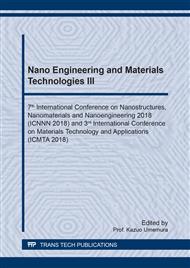[1]
United States Navy: Hospital Corpsman (Naval Education and Training – Professional Development and Technology Center, Florida 2003).
Google Scholar
[2]
S. Baranoski and E. Ayello: Wound Care Essentials: Practice Principles (Lippincott Williams & Wilkins, Philadelphia 2008).
Google Scholar
[3]
A. Platt, A. Phipps and K. Judkins: Burns Vol. 22, No. 7 (1996), pp.543-545.
Google Scholar
[4]
D. L. Steed: The American Journal of Surgery Vol. 187, No. 5 (2004), pp. 71S-74S.
Google Scholar
[5]
Wound Care: A Collaborative Practice Manual for Health Professionals, edited by C. Sussman and B. Bates-Jensen, Lippincott Williams & Wilkins, Philadelphia (2007).
Google Scholar
[6]
V. Jones, J. E. Grey and K. G. Harding: BMJ: British Medical Journal Vol. 332, No. 7544 (2006), p.777–780.
Google Scholar
[7]
N. F. Watson and W. Hodgkin: Surgery (Oxford) Vol. 23, No. 2 (2005), pp.52-55.
Google Scholar
[8]
Biomedical Hydrogels, edited by S. Rimmer, Woodhead Publishing, UK (2011).
Google Scholar
[9]
G. Adler: Science Vol. 141, No. 3578 (1963), pp.321-329.
Google Scholar
[10]
B. Fei, et al.: J. Appl. Polym. Sci. Vol. 78, No. 2 (2000), pp.278-283.
Google Scholar
[11]
J. Rosiak and P. Ulański: Radiation Physics and Chemistry Vol. 55, No. 2 (1999), pp.139-151.
Google Scholar
[12]
J. G. Vasquez and T. P. Tumolva: Am. J. Chem. Vol. 5, No. 2 (2015), pp.60-65.
Google Scholar
[13]
E. Caló and V. V. Khutoryanskiy: Eur. Polym. J. Vol. 65, No. 4 (2015), pp.252-267.
Google Scholar
[14]
A. Sannino, C. Demitri and M. Madaghiele: Materials Vol. 2009 (2009), pp.353-373.
Google Scholar
[15]
R. Pereira, A. Mendes and P. Bártolo: Procedia CIRP Vol. 5 (2013), pp.210-215.
Google Scholar
[16]
T. Kokubo, et al.: J. Biomed. Mater. Res. Vol. 24, No. 6 (1990), pp.721-734.
Google Scholar
[17]
A. Oyane, et al.: J. Biomed. Mater. Res. Vol. 65A, No. 2 (2003), pp.188-195.
Google Scholar
[18]
P. Kang, K. M. Perry and N. Bockstiegel: WOUNDS Vol. 27, No. 1 (2015), pp. E1-E6.
Google Scholar
[19]
R. Rajendran, et al.: Journal of Textile and Apparel, Technology and Management Vol. 7, No. 2 (2011), pp.1-12.
Google Scholar
[20]
S. K.Gulrez, S. Al-Assaf and G. O. Phillips, in: Analysis and Modeling to Technology Applications, edited by A. Carpi, InTechOpen Ltd, UK (2011).
Google Scholar
[21]
A. S. Kipcak, et al.: Journal of Chemistry Vol. 2014 (2014), pp.1-8.
Google Scholar
[22]
D. Basmadjian: Mass Tansfer and Separation Processes: Principles and Applications 2nd Ed. (Hoboken: CRC Press, NJ 2007).
Google Scholar
[23]
J. G. Vasquez: Synthesis and Characterization of a Self-Assembling Hydrogel from Water-soluble Cellulose Derivative and Sodium Hydroxide/Thiourea Solution (unpublished master's thesis). University of the Philippines Diliman (2015).
Google Scholar
[24]
A. L. Ishii, R. W. Healy and R. G. Striegl: A Numerical Solution for the Diffusion Equation in Hydrogeologic Systems (US Geologic Survey Water-Resources Investigation Report 1989).
Google Scholar


